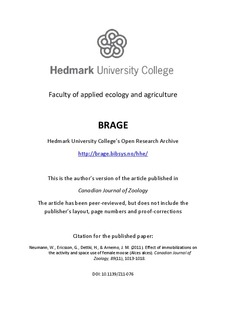Effect of immobilizations on female moose (Alces alces) activity and space use
Journal article, Peer reviewed
Permanent lenke
http://hdl.handle.net/11250/134152Utgivelsesdato
2011Metadata
Vis full innførselSamlinger
Originalversjon
Neumann, W., Ericsson, G., Dettki, H., & Arnemo, J. M. (2011). Effect of immobilizations on the activity and space use of female moose (Alces alces). Canadian Journal of Zoology, 89(11), 1013-1018. 10.1139/Z11-076Sammendrag
Studies of free-ranging wildlife often involve animal capture and fitting of tracking devices. Capturing wildlife may result in behavioral alterations. Thus, there is a need to evaluate the effects of capture on study animals to identify potential biases influencing the research. We assessed the short-term response of 15 GPS/GSM-collared adult female moose (Alces alces L., 1758) and immobilization and handling by comparing moose rates of movement and net square displacement before and after re-capture. Moose were more active up to seven hours and increased their spatial displacement for 4.5 days after re-capture compared to movement patterns before re-capture. Opposing to our predictions, moose did not reduced their rates of movement after their initial displacement following capture and recovery, i.e., moose did not show any indication for a residual effect. We recommend using individuals as their own controls in analyses of capture impacts to account adequately for individual behavioral differences. We recommend omitting data of at least the first five days following capture for analyses of moose movement and distribution.
Beskrivelse
This is the postprint version of the article published in Canadian Journal of Zoology
